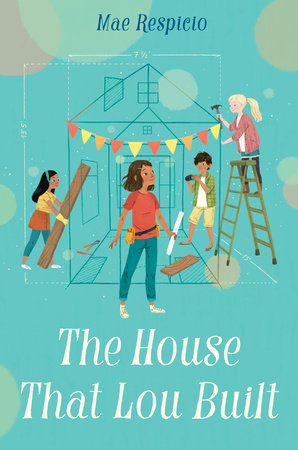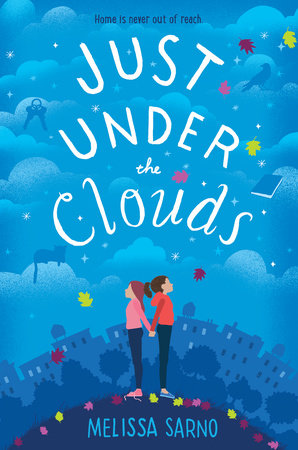Mae Respicio and Melissa Sarno Reflect on the Meaning of Home
by the Brightly Editors
What is home? Is it a place, a feeling, or something else? These are questions that Mae Respicio’s The House That Lou Built and Melissa Sarno’s Just Under the Clouds — two heartwarming novels in which all kinds of middle grade readers will see themselves and their stories — explore in depth. We were thrilled to have Mae Respicio and Melissa Sarno speak with each another in this interview for Brightly about the inspiration behind their books, why a sense of home is so important to kids, and what the word “home” means to them.
MAE RESPICIO: Hi, Melissa! I just finished reading your gorgeous middle grade novel Just Under the Clouds. Could you tell us a little more about it?
MELISSA SARNO: Thank you for reading, Mae! Just Under the Clouds is about 12-year-old Cora Quinn, who is living in a homeless shelter in Brooklyn. When the shelter becomes unsafe, she and her mother and her sister move into a fancy high-rise apartment with her mother’s old friend. At the same time, Cora discovers the “Tree of Heaven,” which her late father, who was a horticulturalist, studied. She begins looking for patterns and connections in all the growing things around Brooklyn to understand the true meaning of home.
I also had the pleasure of reading your heartwarming and beautiful debut. Can you share what it’s about?
MAE: So glad you enjoyed it! The House That Lou Built is about a 12-year-old girl named Lucinda Bulosan-Nelson — Lou for short. Lou has a big dream: to build a tiny house. When Lou discovers that her mom may move them out of state, she decides that building her house is the perfect way to convince her mom to stay, so she rallies her cousins and friends to help. Of course, building a 100-square-foot house is not as easy as she thinks it’s going to be. During their building adventures, Lou gets to discover her world a little more deeply and ultimately learns what makes a true home.
MELISSA: I love Lou and her determination. Why were you drawn to this storyline and the idea of a girl creating a space of her own?
MAE: Growing up, I used to create elaborate forts and dream up secret spaces with my friends. When I came up with the idea, I thought: What kid doesn’t want her own house? I was inspired that a home could symbolize so many different things, especially to a girl exploring her family and community for the first time. Lou’s building a tiny house parallels her inner journey of finding confidence, and of realizing that “home” is where she can always be her true self.
Your main character, Cora, also longs for a space of her own, though she wants this for her whole family since she, her mother, and her sister are homeless. I felt so moved by your story line, especially in thinking about kids who live that experience every day. What led you to exploring this theme?
MELISSA: When I started writing Cora’s story, I wanted to write about a city kid who loved to climb trees. As I wrote, I wondered what made her gravitate toward trees. I started to think a lot about trees and their stability and permanence, the way they are rooted to one place in their lives, which led me to write about a girl who was seeking that in her own life. At the time I started writing the book, I was also a new mother, and that new identity made me question a lot about myself. I felt less comfortable and “at home” in my own skin. So, stability, permanence, and a feeling of home were all rattling around in my head, and I wanted to explore that.
MAE: I loved looking at trees through Cora’s eyes! Okay, I have to quickly ask … have you ever been a tree climber?
MELISSA: I definitely didn’t climb trees the way Cora does! I had one tree at my childhood home, and I would climb to the first footing and sit in it every once in a while. To be honest, it wasn’t all that comfortable.
Lou is also grappling with the concept of home. She and her mother live with their grandmother, her mother’s job might take her to a new city, and she wants to set her roots in her own tiny house. What does “home” come to mean to Lou throughout the book?
MAE: Lou’s idea of what she wants in a home is always morphing — at times she dreams of a house all to herself to escape her lovable but large Filipino family; other times she thinks a tiny house is what she and her mom need to improve their lives. In the end she figures out a home can be lots of things. One of my favorite lines is: “Home is where your heart is. If that’s true, then my home is wherever I am.” When I wrote the book, I thought about the different communities I’ve been a part of — they all feel like home in some way, so that line resonated with me.
MELISSA: I love that line, too! Being at home within yourself is such a beautiful concept.
MAE: It is! I do think middle grade readers are often trying to figure out how to be at home with themselves.
In your novel, Cora spends time in different types of houses, everything from a shelter to a fancy high-rise and even a houseboat. Was it important for her to see the way different families live, and did that somehow change her perception of home?
MELISSA: Yes, Cora does get to observe a few different living spaces throughout the book. Her mother’s friend Willa lives in an expensive apartment that looks perfect, but Cora learns that Willa is very lonely. Her new friend, Sabina, has lived all over the world on a houseboat, but the two friends still have a lot of the same hopes and fears. I wanted Cora to see that there are many ways to live, that no one place has everything, and that she has options, even when it seems like she has none.
Family is at the heart of both of our books. Can you talk about how family relates to a feeling of “home,” both in your life and in Lou’s?
MAE: Lou comes from a big, close-knit extended Filipino American family, which in her world is synonymous with home. I tried to capture that by glimpsing the smells, sounds, and traditions engrained in Lou’s daily life, but also in how she feels when she’s immersed in them. At one point Lou says sometimes she gets a little overwhelmed by those things, but that if they were gone, she’d miss them. I come from a similar family structure, so I was able to dig deep into my own childhood and draw from the feelings and details (and of course family parties with lots of great food!) that I remember about growing up Filipina American.
It’s been fun to read your book and see how differently another character can come to understand the meaning of home. What do you hope readers will remember most about Cora’s journey?
MELISSA: I hope they remember how Cora sees the world. She finds beauty everywhere. Maybe, like Cora, they will look for patterns and connections in all the growing things around them. And I hope they come to understand that home can be more than a place. It can be a person or a feeling inside of you.
I’m curious, what does home mean to you?
MAE: Whenever I step into any of the places I call home, somehow each one feels just right — home is the place where my soul feels most at ease.
What about for you?
MELISSA: I feel a lot like you do about it. Home is a feeling that I’m always welcome and free to be myself. More often, people represent home to me. I feel most at home with the people who accept me for who I am.
Thank you so much for chatting with me about your book and about home, Mae! I think Cora and Lou would be fast friends.
MAE: And thanks, Melissa, for sharing more about your novel! Cora and Lou would have so much fun hanging out. (I’m pretty sure they’d build a tree house together!) They’re both such big dreamers and kind kids—exactly the type of friends I would have wanted growing up.
Readers, we’d love to learn what home means to you. Please post your photos and thoughts on Twitter or Instagram with the #HomeToMe hashtag, and follow us at @melissasarno and @maerespicio to find out more about a very special #HomeToMe giveaway we’ll be doing soon!
-
Learn More About the Books:


